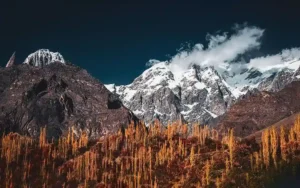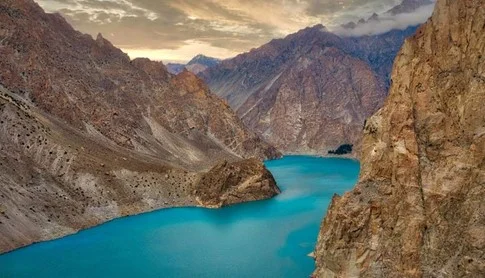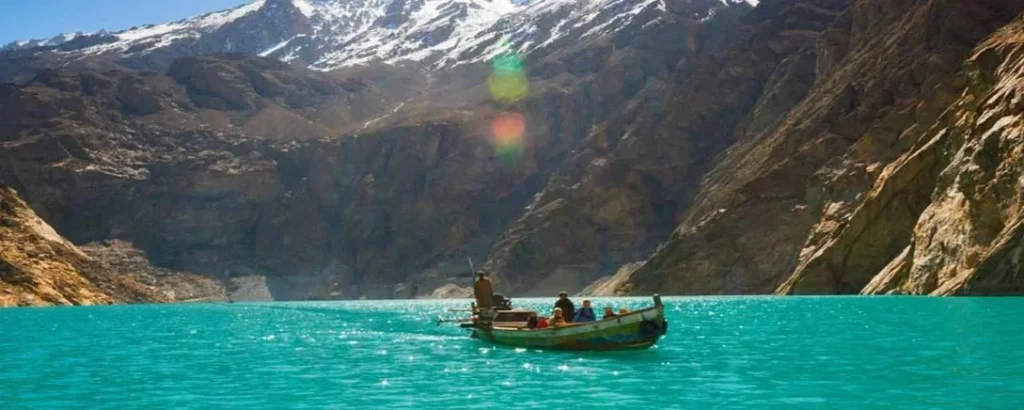
Attabad Lake, nestled in the breathtaking Hunza Valley Lake Pakistan, is one of the most impressive natural wonders of northern Pakistan. For nature lovers, adventure seekers, and photographers, the lake is a must-visit place that has become a charming tourist destination due to its magical blue-green waters and its peaceful landscape. Yet what is so unique about Attabad Lake? Its unique story is what gives it the answer. Attabad Lake is a natural disaster turned into beauty, formed from a natural disaster.
Through this article, Attabad Lake Hunza Valley origin, impact and their importance of tourism and environmental concern and future prospect are explored.
Furthermore, the lake has taken on a cultural significance of strength as the ability of nature not only to face but to bless a community. It is a remarkable story of adaptation and human creativity of a place transformed from one of destruction to a successful tourist hub of Attabad.

Attabad Lake is a tragic and interesting story. On January 4, 2010, a major landslide occurred in Lake region of Hunza Valley, blocking Hunza river and creating a natural dam. As a result, several villages were submerged and thousands people were displaced while the daily life was also disrupted. Despite the extent of devastation, the newly formed Attabad Lake turned into a source of wonder and a major tourist attraction for Hunza Valley Lake Pakistan.
It is the deepest lake in Pakistan, measuring approximately 21 kilometres long, with depths of up to 358 feet and is stretching approximately 21 kilometres long. Infrastructure around the lake developed over time and became better with the government and local authorities, which increased the availability and generated the tourism. Yet, the lake was a barrier for the people of the area because it restricted trade routes and necessitated the adaptation to the new geography. Massive rehabilitation prompted the adoption of new policies regarding disaster response and regional development.
In efforts to minimize the disaster’s impact, tunnels and bridges were built to restore the transportation routes. Government worked with international organizations and engaged it to address socio-economic challenges they faced by the displaced communities. Today, restoration of local livelihood has also been ensured, and these efforts have transformed into a thriving tourist destination.

The subsequent changes in the geography of the region were caused by the formation of Attabad Lake. The closed river altered the local ecosystem, impacting the existence of the aquatic life and agriculture. Long term effects of the landslide are still studied by researchers and geologists and sustainable development in the area is ensured.
The landslide also left new sediment layers formed on this lake, giving rise to the new land formations around the lake. Attabad Lake Hunza Valley is a beautiful scenic location that serves as a favourite spot for geologists and Nature lovers as well since the presence of the stunning cliffs and rocky formations further adds to the beauty of the place. Furthermore, climatic conditions in the direct surrounding have been changed by water movement patterns and the lake depth, which have been studied by researchers.
A change in groundwater patterns affected irrigation and water availability for other agricultural areas around the region. Some farmers suffered an initial set back, especially with irrigation techniques and agricultural adaptation, however, they have learned to cope with this new landscape.
Also, there has been observation regarding the seasonal variation in the water levels and hydrological studies are on. Potential risks of future landslides, sediment deposition and supporting slopes are being assessed by scientists. The results from these studies are useful in developing long-term management strategies that aim at preserving the ecology and tourism together.
Attabad lake today is one of the top attractions in Hunza Valley attracting thousands of tourist to visit. Recreational activities in the lake include:

The arrival of tourists has made the local businesses prosper. Around the lake, hotels, restaurants, and shops selling local handicrafts have grown to boost the economy of Hunza Valley Lake, Pakistan. Employment opportunities have come from the tourism boom and helped the region to economic growth. Moreover, new infrastructure projects such as bridges, tunnels, and road networks have also made the area more accessible to international tourists and adventure seekers.

Nowadays, tour operators have been offering specialized packages, which included cultural involvement experiences to visitors, where they can stay with local families and be a part of these traditional Hunza customs. It has further strengthened local economy and preserved the culture.
Attabad Lake Hunza Valley is an interesting region in terms of history, culture etc. The area of Hunza Valley Lake has been occupied by ancient civilizations and the local communities continue to protect their customs and traditions. Attabad Lake not only has a unique geography with natural beauty but also gives visitors a chance to see the unique culture, hospitality and traditions of Hunza people.
The area is made more charming by traditional Hunza cuisine, music and festivals. You can enjoy Hunza traditional music performed by the local artists with local delicious dishes like Chapshuro, Hunza bread, and apricot-based delicacies. There are annual cultural festivals to commemorate the heritage of the region that involve folk dances, storytelling and craft exhibition.

Archaeological finds in the area of Attabad Lake indicate that the region would have once been at the crossroads of trade on the ancient Silk Road, which further builds historical layers on a rich heritage of its own.

The increase in number of tourist destinations due to Attabad Lake has helped tourism, but has also been a subject of environmental concern. Some of the most crucial challenges include:
Efforts are being made to achieve eco-friendly tourism services. Authorities are making efforts in waste management, responsible tourism, and conservation projects to preserve the lake’s pure beauty. The purpose is to reduce human impact and associated awareness campaigns and conservation projects are undertaken to foster sustainable tourism.
Environmental activists and some local organizations have been constantly urging the government to take stricter measures to regulate commercial activities around the lake. Controlled fishing and reforestation projects are part of eco-tourism projects which tends to balance tourism with conservation.
The future of Attabad Lake Hunza Valley looks encouraging if the tourism practices are sustainable. They are being worked on by the government and environmental organisations.
To create a blueprint which can serve as a template for other ecotourism destinations in Pakistan, as well as of course ecotourism elsewhere in the world, long term sustainability models are being developed with international collaborations with environmental bodies.
Nature undoubtedly pays back for its unpredictability and resistance at Attabad Lake. It’s once a place of tragedy, but has now become one of Pakistan’s prettiest attractions. Attabad Lake is a must visit spot in Hunza Valley either for adventure, relaxation, cultural immersion etc. However, if well planned and practised sustainably, this natural wonder can survive for generations.
By managing tourism and environmental conservation balance rather, Attabad Lake can be a touch of sustainable development being that its glory as well as importance can be followed for future generations. If you are planning to visit Pakistan, do not forget to add Attabad Lake. It’s not a mere destination but almost an experience that would leave you dazed in the presence and beauty of an unrivalled power of nature.